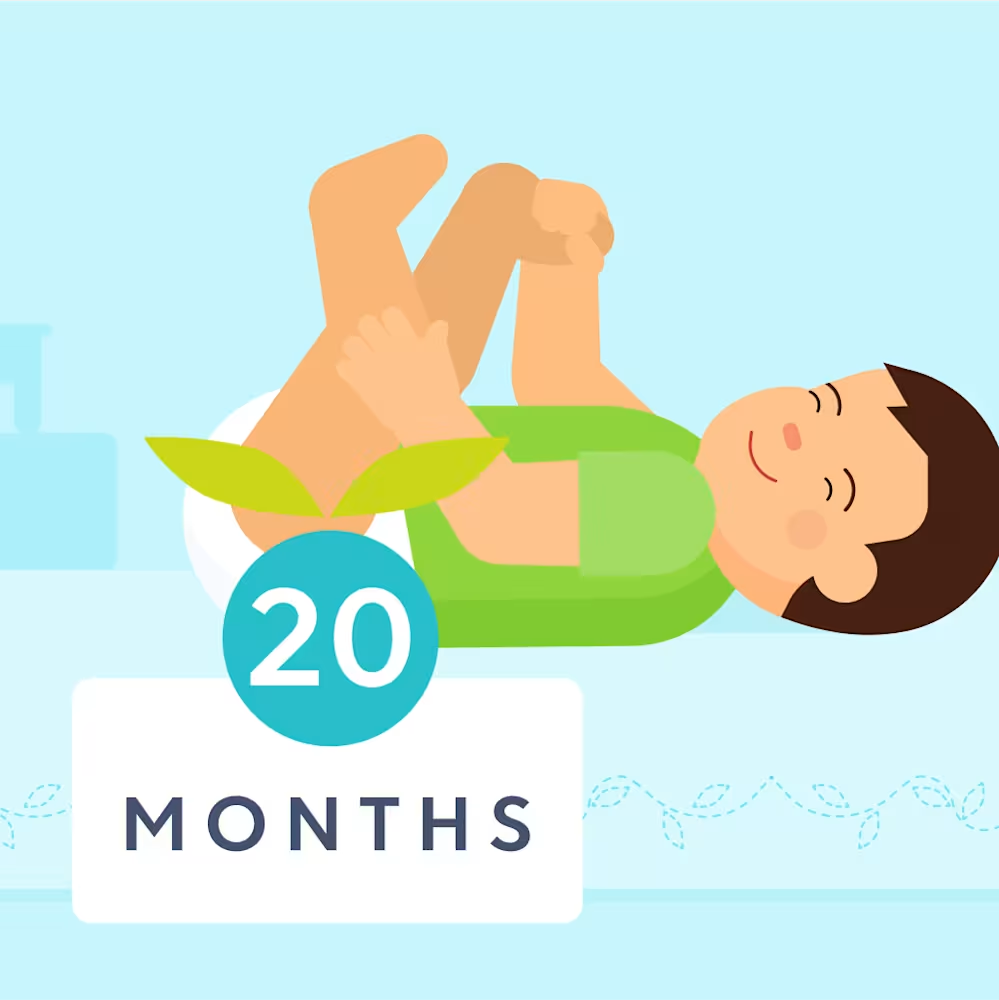20 month sleep regression: Myth or real?
Updated Dec 16, 2025

As you gear up for your toddler’s second birthday, it’s common to see changes in their sleep. You may notice their wake windows lengthening, bedtimes creeping later, and you may even be dealing with an onset of new sleep challenges. If you’re navigating sudden bedtime battles, increased night wakings, or a 20 month old who's resisting sleep altogether, know that while periods of rocky sleep are frustrating, they’re common. Your kiddo is growing and changing so fast at this age!
In this article, we’ll guide you through factors that typically impact sleep at 20 months, share tips on how to get your toddler’s sleep back on track and answer frequently asked questions about sleep at this age.
Table of Contents
Is there a 20 month old sleep regression?
(i.e., periods when your child’s sleep patterns take a sudden turn for the worse) can happen at any age — despite the common misconception that they occur at predetermined months or years. Instead, toddler sleep patterns tend to ebb and flow as they grow. Every child is different — some toddlers may go through a patch of bumpy sleep at 20 months, but certainly not all.
That said, we do see certain patterns that tend to impact sleep for many children in a particular age range. For example, between 16 - 20 months (commonly referred to the “”) as well as around 2 years old (the so-called "”). These periods of rough sleep often coincide with a variety of factors such as nap transitions, physical milestones (like walking), sleep associations, big life changes (starting daycare, welcoming a sibling), illness, and travel — they aren’t dictated by a date on the calendar.
During these times, new sleep challenges may include your child waking up more frequently overnight, waking up early in the morning, and resisting or skipping naps. If any of this sounds familiar, we’d consider this a sleep regression.
How much this period of development impacts a 20 month old’s sleep will depend on their routines and the parent’s response. Let’s take a look at some of the developmental milestones and factors that can influence sleep patterns at this age.
Why do 20 month old toddlers have sleep issues?
Reason #1: They aren’t falling asleep independently
One of the most common reasons children this age struggle with naps or frequent night wakings is that they need help falling asleep. Instead of falling asleep on their own, some little ones rely on an adult to help them snooze — and don’t doze off during naptime or at night without this assistance. This is called a sleep onset association.
Common include feeding, using a rocking motion, and holding or patting a child to sleep. There’s nothing wrong with comforting a child at bedtime; we always encourage comfort and connection during the bedtime routine. However, if a child becomes accustomed to receiving parental help to fall asleep, they may depend on it instead of using self-soothing skills to fall back to sleep. This because if a child wakes up during the night or a nap, they may call out for that same comfort they initially had while falling asleep [].
Reason #2: They’re going through separation anxiety
It’s normal for young children to from their parents, especially up until about age 3. New or increased levels of clinginess are a normal part of healthy child development, but it can make it harder for them to separate from caregivers at sleep times []. During this phase, kiddos who’ve been falling asleep on their own may suddenly want their parents to stay with them and help them fall asleep.
Reason #3: Their sleep needs are changing
As children approach their second birthday, they’re often able to comfortably stay awake for longer periods, meaning they may need a longer wake window to be sufficiently tired before bed. By 24 months, many kiddos need a consistent bedtime that allows for 5.5 - 6 hours of awake time before bed. Going to bed too early often makes it harder for them to settle and bedtime battles may ensue.
In addition to needing a longer wake window, toddlers also benefit from a drawn-out wind-down period in dim lighting to support their circadian rhythm []. Their bodies rely on environmental cues — like a reduction in light — to begin producing melatonin, the hormone that helps signal it's time for sleep. Spending about 45 minutes in a calm, dimly lit environment before bed not only helps them shift out of play mode but also promotes the natural release of melatonin, making it easier to settle down and fall asleep.
Reason #4: They’re pushing boundaries
At this age, 20 month olds are often leaning into toddlerhood and seeking independence. As they begin to explore and test boundaries, it can create challenges around sleep. Bedtime resistance, stalling, and a newfound desire to do things “by myself” are common and developmentally appropriate.
Reason #5: Life changes
Big changes — like a new sibling, a move, or starting daycare — can take time for your 20-month-old to adjust to. These transitions often bring big feelings and can temporarily disrupt sleep, especially if naps are delayed or skipped. Overtiredness can make it harder for toddlers to fall asleep and stay asleep, and you might notice more clinginess at bedtime as they seek comfort and process it all.
Reason #6: They’re teething
Around 20 months, new teeth may break through the gums. may contribute to sleep challenges like night waking, sleep resistance, and clinginess. If your little one is uncomfortable due to new chompers emerging, the pain may make it harder to sleep (sometimes waking them after just 10 - 20 minutes of shuteye instead of in between 50-minute sleep cycles). As a result, toddlers who are teething commonly want more comfort from their parents.
In addition to general discomfort and fussiness, teething can also be accompanied by gum swelling/tenderness, refusal to eat (which may also lead to night wakings from hunger), increased drooling, biting, and chewing.
How long does a 20 month sleep regression last?
Since there’s no predetermined 20 month sleep regression, there’s no scheduled start and stop date either. Although some resources have parents convinced that chaos will ensue at set ages, (like ), your child may have a sudden and significant decline in sleep patterns at 20 months instead — or, not at all. But for those who do, sleep is impacted by many factors and the duration depends on the root cause, the steps taken to improve sleep, and whether new sleep associations are created along the way.
For example, if your 20 month old suddenly has an increase in night wakings because of separation anxiety, it may take them longer to start sleeping through the night again than a kiddo with teething pain that resolves quickly. However, if either toddler develops a new sleep habit while you’re soothing the pain or anxiety, it can turn into a longer sleep challenge.
My 20 month old won’t nap. Does a 20 month regression affect naps?
Sleep regressions don’t exclusively wreak havoc at night — they can also impact naps as well. It’s common for toddlers this age to fight daytime sleep for many of the same reasons they may struggle at night: from separation anxiety and sleep associations to being under or overtired. (And keep in mind that this disrupted daytime sleep can also directly lead to nighttime challenges, or make them worse).
If your 20 month old is resisting naps or on a full-blown nap strike, keep in mind that this is a temporary phase. Most children aren’t ready to completely drop their last nap until they are 3 - 5 years old. When navigating this anti-nap stage, we recommend sticking to your routines and offering that daily nap. Even if your toddler doesn’t sleep, it still gives them a sense of consistency and an opportunity to rest during the day. And they may just surprise you and fall asleep!
If you’re feeling stuck and want more help with your toddler’s sleep, we can help! With, you can submit for a personalized, step-by-step Sleep Plan for your child.
4 tips to handle 20 month old sleep issues or regressions
Tip | Why it helps | What to try |
|---|---|---|
Encourage independent sleep skills. | Toddlers who fall asleep on their own tend to sleep longer with fewer night wakings. | If bedtime relies on rocking, feeding, or staying in the room, gradually reduce the amount of hands-on help. Consider gentle sleep training, and try for a personalized plan. |
Keep things consistent. | Predictable routines help toddlers transition from play to sleep and reduce bedtime battles. | Stick to your usual bedtime routine and offer limited choices (“One last book — bears or dinosaurs?”) to set boundaries without power struggles. |
Be strategic with extra bedtime comfort. | Extra reassurance is sometimes needed, but too much help can create new sleep associations. | Provide cuddles and connection before getting into the sleep space. Avoid adding new habits that your toddler may come to expect. |
Evaluate their schedule. | The right timing helps prevent overtiredness, early wakings, and nap resistance. | Aim for around 13 hours total sleep per day: 10 - 12 hours at night and 2 - 3 hours for one nap. Most 20 month olds need 5 - 5.75 hours awake before and after their nap. |
Find more details below:
Tip #1: Encourage independent sleep skills
If your 20 month old is struggling with sleep, including resisting bedtime and frequent night wakings, evaluate how they’re falling asleep. Toddlers who need help from their parents to fall asleep at night tend to have more sleep challenges and less overall sleep, due to parent-led sleep associations [].
We support families doing what works best for them and their children when it comes to sleep — as long as it’s safe. However, if you’re looking to improve overall sleep for your child (and you!), consider teaching them how to fall asleep without being rocked, fed, held, or otherwise helped to sleep. Instead of physically helping your toddler fall asleep, work towards helping them learn how to fall asleep without you.
One of the common ways you can do this is through sleep training. Yes, you can sleep train toddlers, no, these methods don’t all involve “cry it out.” You can learn about the. If you’re looking for personalized guidance, consider.
Tip #2: Keep things consistent
Toddlers with regular bedtime routines are more likely to sleep longer with fewer night wakings []. Aim to stick to your typical bedtime routine as much as you can, even during phases of bumpy sleep. This consistency signals to your child that it’s time to transition from play to bed, helps them understand what to expect at sleep time, and encourages healthy sleep habits.
We understand that sticking to the typical nighttime ritual may feel impossible at times, especially if your little one is getting clingy or testing boundaries at bedtime. In these moments, it can help to set limits by offering distinct choices. For example, if your little one tends to delay bedtime by asking for more books, you might say: “We’re reading our last book and then it’s time to turn off the lights. Do you want to read this book about bears or this book about dinosaurs?”.
Tip #3: Be strategic with extra bedtime comfort
While consistent sleep routines are the goal, there are times — like teething or separation anxiety — when your little one may need some extra comfort. It’s completely OK to offer more cuddles and reassurance during these moments.
Just keep an eye on how much you're helping them fall asleep. If you start doing more than usual (like staying in the room when you used to leave), it can shift their sleep expectations. Even previously independent sleepers may begin to rely on that extra help at bedtime and during the night.
When possible, try to offer the extra comfort before they’re in their sleep space and the lights go out — that way, they still get the connection without changing the way they fall asleep.
Tip #4: Evaluate their schedule
Toddlers this age typically do best with a set schedule that allows for around 13 hours of total sleep per day: 10 - 12 hours at night and 2 - 3 hours during one daytime nap. If your 20 month old is fighting naps, delaying bedtime or consistently waking early in the mornings, it may be a sign that they need a schedule adjustment. Most 20 month olds need about 5 - 5.75 hours of awake time before and after their nap to be sufficiently tired.
How much sleep does a 20 month old need?
We recommend aiming for about 13 hours of total sleep per day at . That often looks like 10 - 12 hours overnight and 2 - 3 hours of daytime sleep in one nap. However, every child is different and sleep needs can vary. Use your child’s overall mood, behavior, and energy levels when determining if they’re getting the sleep they need. These are general guidelines and if your child sleeps more or less than this, that’s OK too.
How can I tell if it's separation anxiety or 20 month sleep problems?
Separation anxiety can still be present around 20 months, especially as toddlers balance growing independence with a strong need for reassurance. Your child understands that you leave and return, but emotions can feel intense, particularly at bedtime.
Bedtime separations may contribute to sleep challenges like resisting sleep or waking overnight. Offer reassurance, keep routines predictable, and remember this is a normal part of emotional development.
How can I tell if it's teething or 20 month sleep problems?
At 20 months, many toddlers are still cutting molars, which can be uncomfortable. Teething at this stage may lead to soreness, irritability, and disrupted sleep — so it’s not really teething or sleep problems. Extra comfort before bed and consistent routines can help support rest during this phase.
Can you sleep train during a sleep regression?
At 20 months, can help your toddler learn to fall asleep independently, even if their sleep has hit a rough patch. However, keep in mind there are many methods to choose from — the “best” solution for your family is one that fits your child’s temperament and your parenting preferences.
Can I let my 20 month old cry it out during a sleep regression?
The “cry it out” (CIO) method — also known as extinction — can be an option if your toddler is experiencing a sleep regression at 20 months. Some toddlers find frequent check-ins more frustrating, so CIO may work better if gentler methods seem to ramp up the protest. If you go this route, make sure your child’s needs are met first: they should be fed, dry, and in a safe sleep space. A video baby monitor can help you keep an eye on your toddler while allowing them space to settle. As always, reach out to your pediatrician if you have any questions before starting sleep training.
There are also other sleep training techniques to consider. There are gentler approaches that can teach self-soothing skills while offering more support along the way. These methods typically take longer — sometimes a few weeks or more — but can be useful for families who prefer to make slower changes. Trust your instincts and adjust as needed.
What are self-care tips for tired parents?
Phone a friend: The toddler stage can be a wild one! Feeling frustrated, overwhelmed, and exhausted (often all at once!) is pretty typical for parents of children this age. Sometimes, commiserating with a friend or family member who’s in the same boat — or has navigated choppy waters previously — can help give you perspective and reassurance that you’ll get through it too.
Take a pause: Harnessing your calm is often easier said than done, but taking a pause (even if it’s just to get some fresh air and breathe) can help turn your day around. Try slow, deep breaths (you know, like you’ve probably told your toddler!) with a dash of humor when you’re feeling like you’re also ready to have a tantrum. Evaluate your to-do list: Parents juggle so much! Take a quick look at the things on your never-ending to-do list and decide if there are items that can be paused, shared, or delegated. This can help you feel a little more in control of the chaos while still chipping away at the things that need to be done.
Should I let my baby sleep in my bed during a regression?
The American Academy of Pediatrics (AAP) advises against bedsharing for the first 12 months of your child’s life to help reduce the risk of SIDS []. After a year, their guidance becomes less specific — they still don’t officially support bedsharing, but the risk of SIDS decreases significantly by this age.
Many families opt to bring their toddler into bed, especially if it helps everyone get more rest. If you do decide to bedshare, it’s important to prioritize safety. Keep in mind that risks like suffocation, falls, or entrapment can still occur. To help create a safer sleep environment:
Keep the sleep surface firm and flat
Avoid using pillows, comforters, or heavy blankets near your child
Make sure no one sharing the bed is under the influence of alcohol, drugs, or medication that affects alertness
When to talk to a doctor
More often than not when a toddler goes through a period of bumpy sleep it’s nothing to worry about — sleep regressions are a normal part of development. However, if something feels off or your child is struggling more than usual, don’t hesitate to reach out to your healthcare provider. Trust your instincts!
Here are some other instances where you might consider checking in with your child’s doctor:
Unexpected symptoms: Vomiting, fever, rash etc.
Unusual sleepiness: Overly drowsy, hard to wake
Feeding or growth concerns: Consistently refusing food, not gaining weight as expected (though growth naturally slows in year two)
Persistent fussiness: Child is difficult to soothe or appears to be in pain
General concerns: If something doesn’t feel right, it’s often better to err on the side of caution
Takeaway
Sleep regressions are a normal part of development that can happen at any age.
Around 20 months, toddlers may experience disrupted sleep due to various factors, including sleep associations, illness, teething pain, separation anxiety, and adjusting to big life changes. They may also be ready for longer wake windows and more eager to push boundaries.
The length of a sleep regression typically depends on the factors contributing to poor sleep and whether new sleep associations are created.
To help get your 20 month old’s sleep back on track, encourage independent sleep skills, keep things consistent, comfort them strategically, and evaluate your child’s schedule.
20 month sleep regression FAQ
Share article:
Note: The content on this site is for informational purposes only and should not replace medical advice from your doctor, pediatrician, or medical professional. If you have questions or concerns, you should contact a medical professional.
7 Sources
Table of Contents
Share article:






